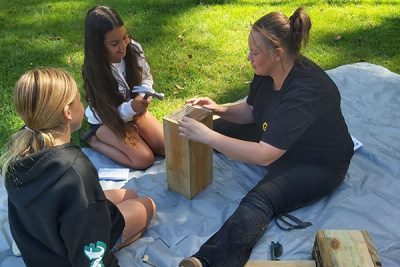
Predator Free 2050 has the goal of completely removing rats, stoats and possums.
Despite the best of intentions, it can be a struggle for volunteer community Predator Free groups to meet the goal of eliminating rats, possums and mustelids due to competition for resources and funding.
For this reason, Go Eco set up the Central Waikato Predator Free Hub, which harnesses the power of collective action to maximise the effectiveness of community predator free groups.
“The hub was a collaborative initiative of Go Eco, Waikato Regional Council, NZ Landcare Trust, Predator Free Hamilton, Predator Free Cambridge and the Department of Conservation, all who have representation on a steering group,” says Go Eco chief executive Jo Wrigley.

Building tunnel boxes at Lake Te Koo Utu, Cambridge.
“We all met to identify the challenges around a growing number of small groups and initiatives, small contestable pools of funding, group succession and longevity, and community engagement in safe and ethical predator control. The group developed a strategy, and Go Eco picked up the operationalisation of the strategy, along with the challenge of finding start-up funding.”
The hub was set up last year with funding by Wel Energy Trust Vital Initiatives. Waikato Regional Council also approved a grant of $38,976 over three years from its Environmental Initiatives Fund.
Predator Free 2050 was set up by the government in 2016 with the goal to completely remove rats, stoats and possums – the three most damaging introduced mammalian predators to our natural taonga.

Predator Free Cambridge is one of 67 groups supported by the hub.
Jo says there are 67 Predator Free groups of all shapes and sizes that are now part of the Central Waikato hub, which is centred around the Hamilton basin.
“There are many people who are passionate about their environment and have got involved in this mission, but the work can feel quite fragmented, isolating and overwhelming, with groups competing for short-term resources and often struggling to find the time and expertise needed to apply for funds successfully.
“Even neighbouring predator control initiatives are often uncoordinated, so the hub aims to improve the effectiveness, impact and sustainability of these groups.

The hub holds regular educational workshops, connecting volunteers with experts.
“We support our groups by taking a collective approach to funding applications, which reduces competition and improves the success rate of applications.
“And we’ve developed bulk collective purchasing power through the hub, which enables groups to seasonally purchase items from trapping and baiting suppliers at discounted rates and reduced freight costs to get better value from their funding.”
The hub also hosts regular networking events and themed educational workshops, which puts volunteers in contact with each other and experts in their field.

A trapping workshop with Sam the Trap Man.
“These can be anything from trap building to health and safety.”
Jo says the gatherings provide a wealth of information about not just predator control, but also around restoration and riparian planting and catchment work.
“We’re finding out how diverse the groups can be. Predator Free groups are usually lumped into one group of ‘people who trap’ but there is so much more to it than that.
“We’ve got industry and business and industrial zones who undertake Predator Free control and who are willing partners; groups are forming and expanding under the regional and district councils; retirement villages have very enthusiastic trapping tunnel box builders, and schools also enthusiastic for educational purposes; and then there are projects like Bush to Burbs that seek to work with farmers, landowners and rural communities.
“There is so much opportunity to blend the work of Predator Free with the ongoing work around restoration and riparian planting, river and catchment management work, and education. We're trying to build narratives of care and reciprocity and connect people so that we're all in.”

